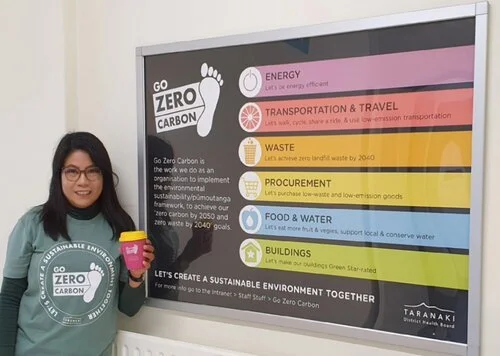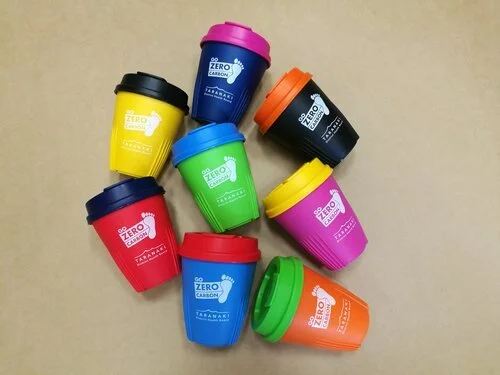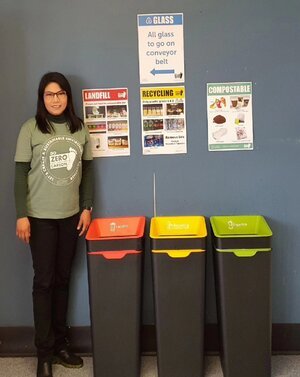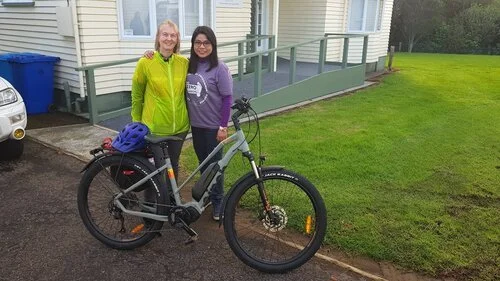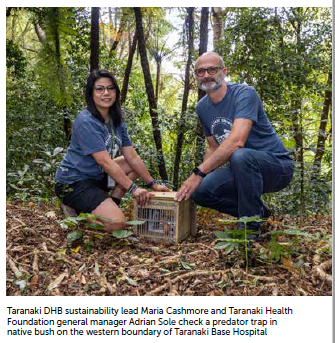June Sustainable Business Champion - Taranaki DHB
Making huge strides in just 18 months, the Taranaki District Health Board is racing towards its environmental goals. By 2040, there will be zero landfill waste, and currently, that would be a diversion of 288 tonnes. Maria Cashmore explains the many initiatives underway.
The Sustainability Lead role is a sole charged position that includes developing and implementing Taranaki DHB’s sustainability strategies, projects, and operations to address climate adaptation and mitigation responses on key focus areas: waste, procurement, transportation, energy, green buildings, green spaces, healthy food, and water conservation.
Targets:
Zero Carbon By 2025
Offset Other Emissions By 2030
Zero Landfill Waste By 2040
Healthy Communities, A Healthy Environment, And Cost Savings/Neutral
Since her employment, Maria Cashmore has made some big overhauls at Taranaki DHB, one of Taranaki’s largest employers. She is systematically tackling key areas that will inch them closer to their competitive targets, setting the standard for not only the soon-to-be centralised national hospital infrastructure but also for businesses, councils, organisations, and schools.
To validate and benchmark their efforts, Toitu Envirocare has measured Taranaki DHB’s carbon emission sources and verified their Emission Management and Reduction Plan (EMRP). The Emissions Inventory and EMRP are reviewed, updated, and verified annually to ensure that they are meeting their targets.
Taranaki DHB is now diverting 18 waste streams from landfill: paper, tins and aluminum, cardboard, toner cartridges, batteries, mobile phones, plastic grade 1, 2, and 5, plastic grade 3 or PVC, soft plastic, glass and vials, milk bottles and lids, electronic waste, some medical equipment, fluorescent bulbs, metal, single-use scissors, tweezers, and forceps; shrinkwrap, food, and other compostable items. For example, styrofoam and wax-lined non-biodegradable single-use cups have been removed and replaced with compostable cups.
The majority (80-90%) of packaging and single-use items from the cafeteria have been replaced with compostable or recyclable options including bin liners.
Eight battery stations are in the process of being distributed at the Base and Hawera Hospital.
Reprocessing of Sequential Compression Devices and Patient Transfer Mattresses is being undertaken. Learn more about this in our Talking Taiao Interview.
·Liquid and oral drug denaturation waste process is being trialed.
Home PVC Recycling Program for home dialysis patients was launched last month.
Introduced circular reusable cups and 60L waste bins – Circular means broken reusable cups/lids and waste bins can be returned to the supplier to be reprocessed into new cups/lids and bins; therefore, will never end up in the landfill.
For more information check out Taranaki DHB’s new Sustainability Go Zero Carbon page.
Go Zero Carbon week is held annually to increase staff awareness on sustainability, recognise staff contributions, and encourage staff to participate in fun-filled activities. Monday 28 June – Friday 2 July is the annual Go Zero Carbon Week. We are encouraging our staff to:
o Smoothie Bike Challenge! The aim is to make a smoothie (and drink it too) as quickly as you can using your own pedal power on the smoothie bike.
o Ask the experts and try the e-bikes and e-scooters on show and learn about the e-bike and e-scooter discount scheme.
o Join the healthy food shared lunch get-together.
o Check out the Veggie Tuesday menu offered at Hawera Hospital cafeteria and Café Revive at the Base.
o Nominate a colleague for the Environmental Sustainability MORE Awards and be in the run for the Environmental Sustainability Champion 2021.
In an effort to prioritise and protect Taranaki DHB’s green spaces, Maria has been working with the Taranaki Regional Council in implementing the Predator Free Program. Rat and stoat traps have been set within the Base hospital’s native bush area.
Sustainable community gardens at the Base and Hawera hospitals are being developed with iwi – Kahui tikanga, sustainability non-profit groups, and the community. To celebrate their orchards, an annual Apple Crumble Event gets patients out and about to pick apples and learn to make apple crumble/desserts.
Sustainable transportation is also a major focus area, as the Taranaki DBH is a beehive of over 2500 commuters daily. Most people don’t realise that transport represents 50 percent of our greenhouse gas emissions. Read more about active transport options in Taranaki and tackling the urgent climate crisis, as well as green transport for businesses.
The hospital has implemented Flexible Working Guidelines and fleet optimisation strategies, as well as a low emission vehicle transition plan. Maria is also working on updating the Travel Management Plan to reflect medium to long-term sustainable transportation to and from work and improving the linkage of cycle and pedestrian pathways into the campus.
To further promote active transportation (cycling, walking, scooter, running) Taranaki DHB has provided end of travel facilities such as showers and lockers for staff. There are sheltered outdoor secure bike parks and a bike repair station, and plans are in place for a new bike park building that will cater to approximately 60 additional bike parks. The location of active transportation facilities has been mapped and staff can access this via the Go Zero Carbon website.
Taranaki DHB’s staff carpooling scheme with Guaranteed Ride Home and 30 reserved carpool car parks has also helped to reduce the number of vehicles on the road each day. There are more than 100 staff members participating in the scheme.
In terms of energy, Taranaki DHB received 1.080 million in funding to replace or bypass their gas boiler with a lower emission alternative energy source. Taranaki DHB will also invest $1.620 million from its own budget. EECA estimates this project will reduce carbon emissions by around 10,040 tonnes over the next ten years (around 1,004 tonnes per annum on average over ten years). They are also working on an LED light installation proposal.
Finally, the new east wing building is being created to meet the green star performance rating of the New Zealand Green Building Council requirements. It will be the first of its kind in New Zealand. More about this in our radio interview with Maria.
We hope to give more updates about Taranaki DHB and the progress they are making in our region. If you are a business owner or know of a business that should be nominated as our next Sustainable Business Champion, please get in touch. We’d love to learn more and highlight your story in our community.

